Restructuring below here
The real question for innovators is not “how do we add value?” but “how do we (help) make better progress?”. Deliver what progress seekers truly want: better progress (functional, non-functional, contextual) with lower progress hurdles and quicker value recognition.
Which progress levers are you using to turn innovation from an often disappointing gamble into repeatable success?
What we’re thinking
We have an innovation problem where, not least, 94% of executives are unhappy with innovation initiatives.
By seeing the world through a progress-first lens, we have the solution.
Be gone chasing ill-defined ”added value”, so long mismatched expectations, and farewell innovation theatre. Instead, Innovation becomes operational: the creation or reconfiguration of ways to make progress better and better progress than a Progress Seeker currently can.
Say hello to creating and executing new – to the individual, firm, market, industry, world – progress proposition(s), that offer some combination of:
- aligning closer to a Seeker’s progress sought (and progress origin)
- improving how to make existing progress
- reducing one or more of the six progress hurdles to making progress
- increasing amounts and/or frequency of seeker’s recognising emerged value
When presenting his job-to-be-done theory, Christensen wrote about competing against luck; the Progress Economy supercharges that, revealing an operating model and multiples levers helping you to more systematically, and successfully, innovate.
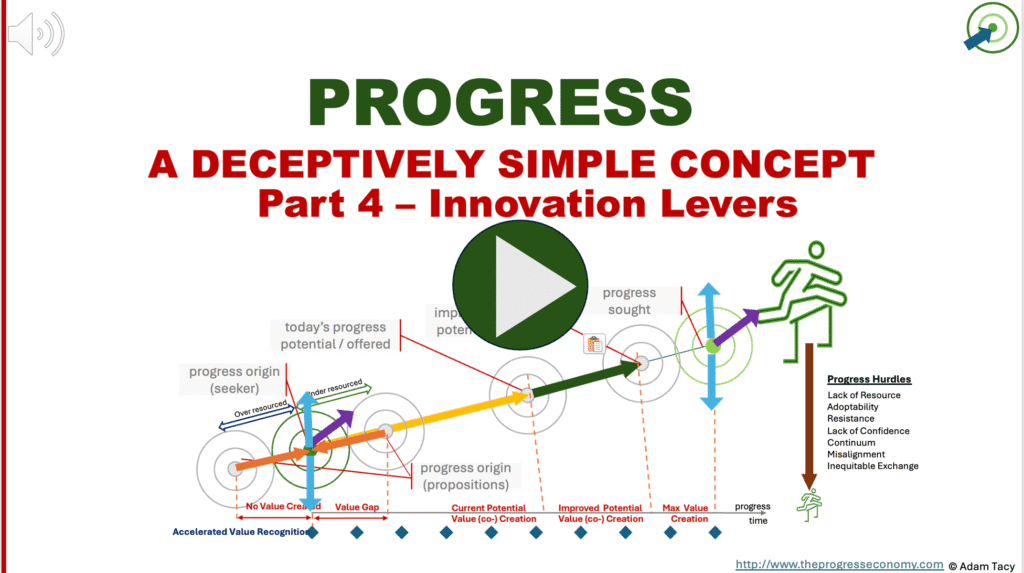
The real question is not “how do we add value?” but “how do we make better progress?” (and for Progress Helpers: “how do we help make better progress?”). Consider:
- B2C: Streaming platforms did not just add “value” over DVDs – they removed friction from the progress of accessing and enjoying entertainment.
- B2B: Cloud infrastructure providers did not simply offer cheaper servers – they enabled businesses to scale without owning data centers, shifting capital expenditure to operating expenditure and reducing operational risk.
- Public sector: Digital identity programs don’t just improve “efficiency” – they help citizens progress through life events (opening a bank account, accessing healthcare) with less administrative friction.
Which progress levers are you choosing to apply to systematically, and successfully, innovate?
The innovation mandate
This is the mandate for leaders: innovation is not optional.
Your Seekers’ are constantly looking to make better progress and their expectations of progress are evolving with every progress attempt they make. The real question is whether you will be the one helping them make better progress, or whether someone else will seize that opportunity.
What will you innovate to stay ahead of your Seekers’ evolving progress – and ensure they still choose you tomorrow?
This is why the progress levers that fall out of the progress-first perspective matter. To avoid drifting into irrelevance, leaders must continuously pull the levers that:
- Make today’s progress better (reducing friction, improving reliability, simplifying complexity)
- Enable better progress than today (new capabilities, new outcomes, new experiences)
- Lower progress hurdles (lack of capability, lack of confidence, adoptability, resistance, inequitable exchange, misalignment on continuum)
- Accelerate value recognition (so Seekers feel rewarded earlier in their journey)
Innovation: making progress better, or better progress, than today
Since value emerges from progress, and that we can more precisely define and make progress actionable, it makes sense our definition of innovation revolves around progress. Here is our progress economy definition:
innovation: creating and executing new – to the individual, organisation, market, industry, world – progress propositions that offers some combination of:
- making progress better
- making better progress
- reducing one or more of the six progress hurdles
- increasing possibility of value recognition frequency
whilst maintaining, or improving, the survivability of the innovator and/or ecosystem
This definition is already more actionable than a vague one about adding value.
Innovation is creating and executing new propositions that offer some combination of: i) making today’s progress better, ii) making better progress than today, iii) reducing one or more of the six progress hurdles and/or iv) increasing possibility of value recognition frequency.
And from understanding progress, we further uncover a set of progress levers — points of influence that we can use to systematically drive innovation. These levers turn innovation into a deliberate act of engineering progress rather than a guessing game of “adding value.” – we are minimising “competing with luck”.
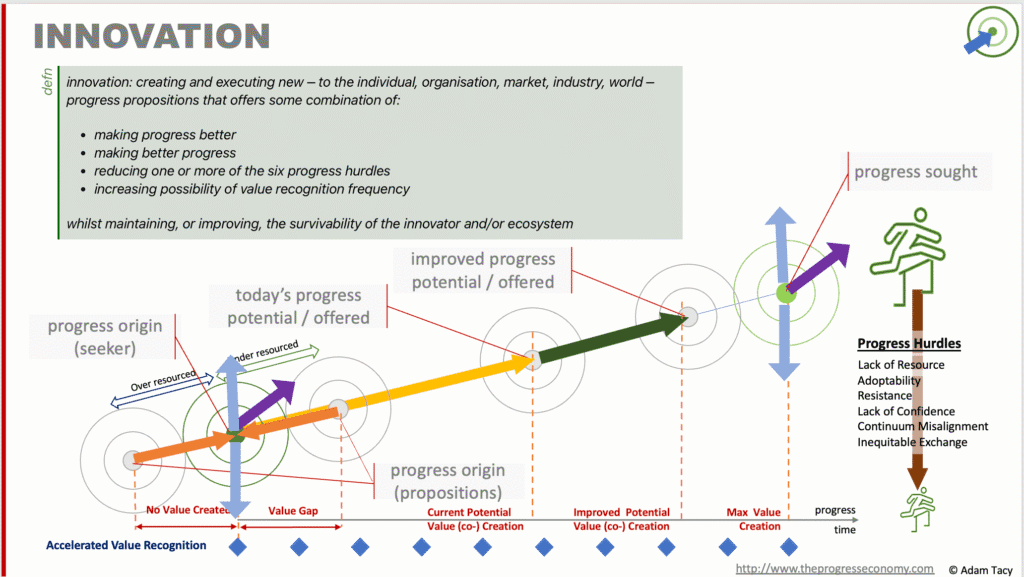
When innovation is seen as improving progress-making, its purpose becomes clearer: it is not about what we create, but about what progress is unlocked.
Let’s dig into what each of these definition components mean. If you want to jump straight to the levers, they are over here.
Creating and executing progress propositions…
Progress propositions are bundles of supplementary capabilities, carried by a proposition-specific resource mix, aimed at reducing a Seeker’s lack of capability for a progress attempt. They offer to help a Seeker make progress better and/or make better progress than they can on their own. Fundamentally, they comprise two bundles:
- a proposed series of progress-making activities
- a resource mix that carries the capabilities the Seeker is lacking
Consider Peloton. It does not simply sell a bike; it bundles a physical product, live-streamed classes, gamified leaderboards, and an online community. This combination appeals to Seekers looking to make fitness progress in a more engaging, sustainable way than they might with a bike alone.
These two components come from our definition of a progress proposition:
Just from this definition we have five elements that are ripe for innovation in a proposition.
| element | example |
|---|---|
| progress offered | Tesla continuously pushes (non-functional) progress offered closer towards a sought “zero emissions mobility” with longer range batteries and faster charging. |
| progress origin (of the proposition) | Canva aligns its offering’s starting point with design novices, making professional-quality outputs accessible to those who have limited design skills without the need for hiring separate design experts. |
| progress-making activities | Domino’s reinvented its pizza-making and delivery process with AI forecasting and real-time order tracking, turning “waiting for food” into a transparent, predictable experience. Stripe removed the complexity of payment gateway integration, enabling businesses – even startups – to accept online payments in hours rather than weeks |
| individual elements of the resource mix | Delta Airlines invested in employee training and mobile gate tools, enabling faster, more personalised service. |
| resource mix offered | Spotify enables those searching for entertainment by swapping out goods (CDs, vinyl) for digital goods, whilst also altering the ownership model. |
Altering the resource mix has leads to some of today’s most significant innovations.
Servitisation replaces goods with physical resources where ownership transfer does not occur, as Rolls-Royce did with “power by the hour”. Digitisation lowers employee intensity while increasing systems – as Slack did when replacing fragmented communication tools with a unified platform. Artificial intelligence (AI) encapsulates knowledge and skills that Seekers augment themselves with, such as Salesforce’s Einstein AI recommending sales actions. Digital twins combine systems and interpretation resources to create real-time operational insight, as GE Digital does for industrial equipment. Shifting online (bricks to clicks) reduces physical locations, increasing scalability – as Shopify did for small businesses seeking to launch e-commerce storefronts.∑
Innovation also occurs at the ecosystem level. Amazon, recognising that Seekers’ definition of progress sought was shifting toward “I want my package tomorrow” moved to build its own last-mile delivery network, reducing dependency on third parties and controlling more of the progress journey. Apple went further, creating a tightly integrated ecosystem of hardware, software, and services to align with Seekers’ progress sought of “a seamless digital life” and “effortless continuity across devices”.
Other retailers reflect a different kind of progress sought: “I want to choose how the last mile delivery occurs.” In markets such as Scandinavia or Germany, Seekers often want flexibility: delivery to the home, an ecological “green” option, pick-up at a staffed parcel agent, or retrieval from a digitally unlocked locker box. Innovators have responded by unbundling last-mile delivery into configurable choices at checkout, letting Seekers align logistics with their own progress priorities — convenience, sustainability, cost, or control.
Notice that in none of these cases have we needed to talk about “adding value.” The organising principle is progress: better progress for the Seeker, made possible by reducing hurdles, reconfiguring activities, or shifting the resource mix. When progress is improved, value follows.
…that are new to the individual, organisation, market, industry, or world
Innovation should be novel. But novel to whom?
It’s tempting to assume innovation must be new to the world. But second movers often create massive value by reconfiguring or repurposing innovations for a new audience. Cloud-based ERP is not “new to the world,” but for a mid-market manufacturer adopting it for the first time, it is innovation — it enables better progress than their on-premise system ever could.
ISO’s innovation definition is that ”novelty is relative to, and determined by the perception of the organisations and interested parties”. That’s a nice political fudge. I prefer the Edison, bin Ali, and Torkar (2013) framing: innovation can be new to the individual, firm, market, industry, or the world. This opens up multiple innovation pathways:
Novelty of innovation, taken from Ali and Torkar’s (2013) in “Towards Innovation in the Software Industry”
New to firm / individual “The minimum level of novelty of innovation is that it must be new to firm. It is defined as the adoption of an idea, practice or behaviour whether a system, policy, program, device, process, product, technology or administrative practice that is new to the adopting organisation (Damanpour, 1992; Hage, 1999; Parashar and Sunil Kumar, 2005; Berger and Revilla Diez, 2006; Fruhling and Keng, 2007; Linton, 2007; Carmona-Lavado et al., 2010).”.
I also add new to individual here, reflecting that the innovator could be a single Seeker.New to market “When the firm is the first to introduce the innovation to its market (Acs and Audretsch, 1988; OECD, 2005).” New industry “These innovations are new to the firm’s industry sector (Garcia and Calantone, 2002; De Jong and Vermeulen,2006; Beugelsdijk, 2008).” New to world “These innovations imply a greater degree of novelty than new to the market and include innovations first introduced by the firm to all markets and industries, domestic and international (OECD, 2005; Berger and Revilla Diez, 2006).”
Now we can see new to the world innovations are those such as CRISPR gene editing or quantum computing both offering entirely new ways of making progress. New to market might be a logistics player introducing dynamic route optimization to a region where route planning was previously static and manual. Whereas new to industry could be a construction company adopting “digital twins” for project monitoring – a practice carried from aerospace engineering. And new to firm is a mid-sized hospital deploying robotic process automation to streamline billing – a solution proven in other healthcare operations but new to that firm.
Carrying innovation from one market/industry to another
This categorisation is powerful because it highlights that innovations can be – as den Hertog notes – carried across firms, industries, and markets (see “Knowledge-Intensive Business Services As Co-Producers Of Innovation“). What begins as a “new to the world” innovation often becomes progressively carried into other contexts if it proves its ability to help Seekers make better progress.
Carrying can be proactive. Many Knowledge-Intensive Business Services (KIBS) firms, particularly consultants, make a business out of this. They spot successful innovations in one client, sector, or geography and transplant them elsewhere. The QR code is a classic example: born in manufacturing for tracking parts, it was carried into retail, payments, transport, entertainment, and even healthcare.
B2B examples abound. Predictive maintenance, for instance, first proved itself in aerospace, where uptime and safety are paramount. It was then carried into manufacturing, logistics, and even energy infrastructure to reduce downtime and extend asset life. Agile development methods, once confined to software engineering, have been carried into hardware design, marketing, and even strategy development as organisations recognised their power to de-risk innovation and respond faster to changing Seeker needs. These are examples of a form of innovation push: proactive transfer by Helpers who see the opportunity to deliver better progress elsewhere.
But carrying is also frequently pulled by Seekers. When they experience an innovation that genuinely helps them make progress, they start expecting it in other domains. QR codes again illustrate this dynamic: once travellers became accustomed to using them as boarding passes, they began expecting them as event tickets, payment mechanisms, and authentication tools. B2B Seekers behave the same way. A procurement team that has experienced frictionless supplier onboarding with a digital identity solution may begin to demand similar simplicity from all its vendors. This is a form of innovation pull: latent demand meeting available capability.
These push-and-pull dynamics sit alongside Rogers’ seminal work on innovation diffusion and adoption (“Diffusion of Innovation”), reminding us that the spread of innovation is not random — it is driven by progress needs, context, and capability alignment.
…that offer some combination of
Our definition of innovation has already advanced beyond the generic “add value” mantra. We have a clearer, more actionable view of what novelty means – new to world, industry, market, organisation/individual, and we have defined innovation relates to a proposition, containing a proposed series of progress-making activities and a resource mix carrying the capabilities the Seeker lacks; offering to help them make their progress in the way they want to.
Now we’ll take this one step further by scoping innovation through the progress diagram. It is not enough to create something new; the question becomes: does it enable better progress? This leads us to four actionable high level levers that any innovation should aim to pull – individually or in combination:
- Enabling better progress than today – getting closer to Seekers’ progress sought by offering additional needed capabilities. Zoom enabled remote teams to work together as if co-located, not just improving conference calls but redefining what was possible
- Making today’s progress better – Reduce friction, improve reliability, or simplify complexity in how progress is currently made. For example, Uber made the existing process of hailing a taxi faster, more transparent, and more reliable.
- Lowering one or more of the progress hurdles (lack of capability, lack of confidence, adoptability, resistance, inequitable exchange, misalignment on continuum). Stripe removed the technical and contractual hurdles of online payments, allowing businesses of any size to start taking payments in hours instead of weeks
- Accelerating possibility of value recognition – helping Seekers feel they can recognise value earlier. Agile approaches do this by guiding seekers to prioritise and retrospect in smaller “sprints” rather than having to wait until the end.
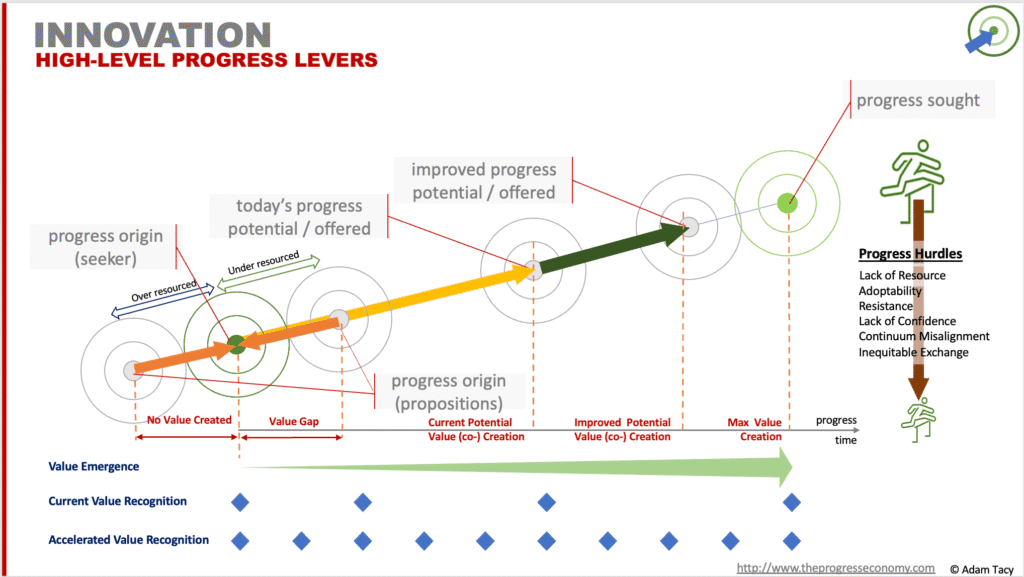
These can be interlinked – reducing a progress hurdle might also enable further progress towards progress sought.
Let’s look at these individually.
…ENABLING better progress
The most obvious focus of innovation is to create propositions that help a Seeker make more progress toward their progress sought than they can today.
On a progress diagram, this is represented by moving the Seeker closer to their desired state – covering some combination of functional, non-functional, and contextual elements.
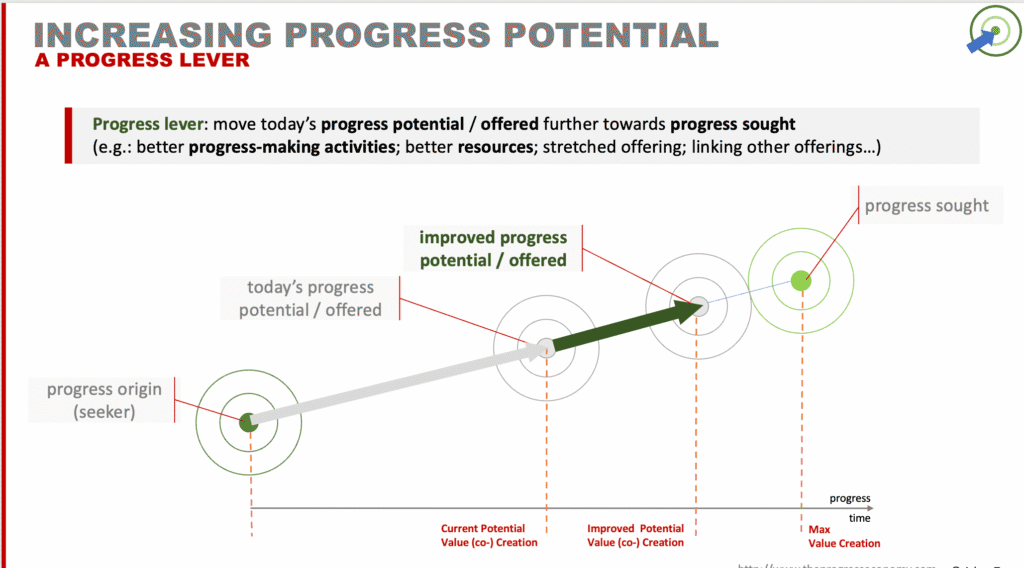
Take Tesla as an example. Their innovation journey is fundamentally about meeting Seekers’ progress sought dimension of “zero-emission mobility” within the context of “familiar usage patterns”. Early electric vehicles, of this cycle, had limited range, which meant progress on “familiar usage patterns” was largely unmet. Therefore, the progress sought dimension of zero-emission mobility felt incomplete.
Tesla’s introduction of a supercharging network, along with faster charging technologies, slowly extended usable range and helped Seekers get closer to the contextual progress they are seeking. Subsequent innovations in battery capacity, software-based route planning, charging convenience, etc, further closes the gap between Tesla’s progress offered and Seekers’ progress sought.
A key insight insight the progress diagram shows us is: progress improvement must be anchored to what Seekers actually want. Too often, innovation efforts are internally driven, building features or capabilities that don’t map to real progress sought.
This also applies at the starting end of the progress journey. Your proposition’s progress origin likely doesn’t match the progress origin of all your Seekers. You may not be offering enough capabilities – and so still leaving a challenge for Seekers – or offering too many – which may lead to higher than necessary price or Seeker frustration. And so innovation to close that gap is often found helpful.
This innovation principle applies equally at the starting point of the journey – the progress origin. If your proposition’s progress origin is too far ahead of where Seekers actually are, they may lack the capabilities to engage. If it is too far behind, they may perceive your offer as dated, insufficient, or frustratingly forcing them to do things they don’t need.
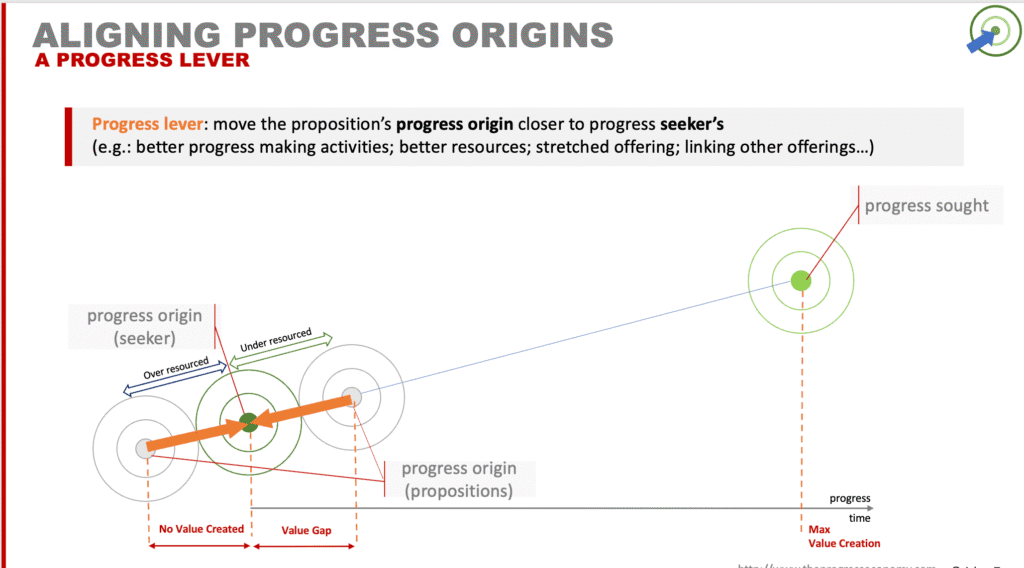
Canva provides a clear example. They innovated to align their progress origin with design novices, offering professional-quality outputs through a radically simplified interface. This allowed anyone – from a small business owner to a social media manager – to create high-quality graphics without hiring a designer or learning advanced tools like Photoshop. Their target Seeker is not a design professional, who may find the tooling too basic or too constraining. These Seekers are probably more suited to the likes of Photoshop. From this we get another insight: you should segment Seekers on progress origin, and likely progress sought.
Innovation to better align your proposition’s progress offered and progress origin with a Seeker’s progress sought and progress origin can take many forms. It can mean bundling other Helpers’ propositions, incorporating their capabilities directly into your offering, or even deliberately unbundling capabilities to give Seekers more choice.
The online retail world offers rich examples.
Traditionally, retailers bundled last-mile delivery into a seamless proposition, allying with a single logistics provider.
Amazon famously shifted this model by making its own delivery capability, allowing tighter control over speed, reliability, and customer experience – better aligning with Seekers’ progress sought of “fast, predictable delivery.”
In contrast, other retailers have taken the opposite approach and unbundled delivery. They allow Seekers to choose at checkout (buy) who they want to handle last-mile delivery. In Sweden, for example, consumers can select between legacy Post Office services (often delivering to a pickup agent), self-collect automated lockers, or eco-delivery via bicycle – reflecting progress sought such as “I want delivered to my door” or “I want to pick up at a convenient location on my time wish” or “I want a more sustainable option.”
This is a modern expression of Williamson’s transaction cost economics: make, buy, or ally. But instead of being driven primarily by production economics or hold-ups, these decisions are now increasingly driven by Seekers’ evolving progress sought.
Innovation here can also emerge in surprising places. In northern Sweden, buses have long transported goods between remote towns as a way to utilize existing transport capacity. ICA, a major Swedish supermarket chain, has taken this further with ICA Paket — using spare capacity in its supply chain to transport parcels from select retailers to ICA stores for pickup. This not only improves asset utilisation for ICA but also helps Seekers make progress by offering them a convenient, trusted location for parcel collection as part of their normal shopping routines.
This same bundling/unbundling dynamic is visible in B2B markets. Enterprise SaaS providers have increasingly bundled once-separate capabilities into a single progress proposition. For instance, Slack’s integration with Zoom and Google Drive reduces friction for teams by embedding collaboration, meetings, and file sharing in one place – aligning progress offered with teams that want to stay in-flow without switching tools.
Conversely, some companies are unbundling to give enterprise customers more control. AWS, Azure, and GCP have progressively decomposed monolithic offerings into microservices, letting Seekers compose infrastructure to their exact needs – offering “just enough” capabilities and aligning more precisely to their progress sought and origins. This helps Seekers avoid overbuying capacity they cannot yet use, or underbuying and creating capability gaps.
In manufacturing and industrial settings, this principle is visible in how capital equipment providers now think about aligning progress.
- Bundling capabilities: Siemens, GE, and other OEMs now bundle predictive maintenance and remote monitoring into their industrial equipment offerings. This aligns with Seekers’ progress sought of “maximising uptime” and “reducing unplanned downtime.” It also helps close the progress origin gap for customers who lack internal analytics capabilities.
- Ecosystem alignment: Mining and construction equipment makers like Caterpillar and Komatsu increasingly integrate with telematics providers, data platforms, and even third-party service networks to help Seekers make progress toward safety, productivity, and sustainability goals.
Even logistics providers are innovating at the level of progress alignment. Maersk’s “integrator” strategy bundles port-to-port shipping, customs clearance, warehousing, and inland transport into a single proposition. This helps shippers whose progress origin was fragmented – dealing with multiple vendors – by reducing complexity and aligning with the progress sought of “visibility and reliability across the whole supply chain”.
These examples show that aligning progress origin/offered with Seekers’ states is not just a matter of tweaking features – it can reshape your boundaries as a firm, shift alliances, and reconfigure ecosystems. The innovation question arises: where can/should you bundle, unbundle, or reconfigure capabilities to better match Seekers’ evolving journey?
…making Today’s progress better
Alongside enabling better progress than today, innovation efforts can also focus on offering to make today’s progress better.
Although this is really a cognitive shortcut…it’s quite meaningless to improve making today’s progress without either improving non-functional/contextual progress, reducing progress hurdles, or increasing value recognition frequency. What we’re really talking about is improving anything except functional progress. And that’s OK, as long as you just remember this.
Here it is conceptually on a progress diagram.
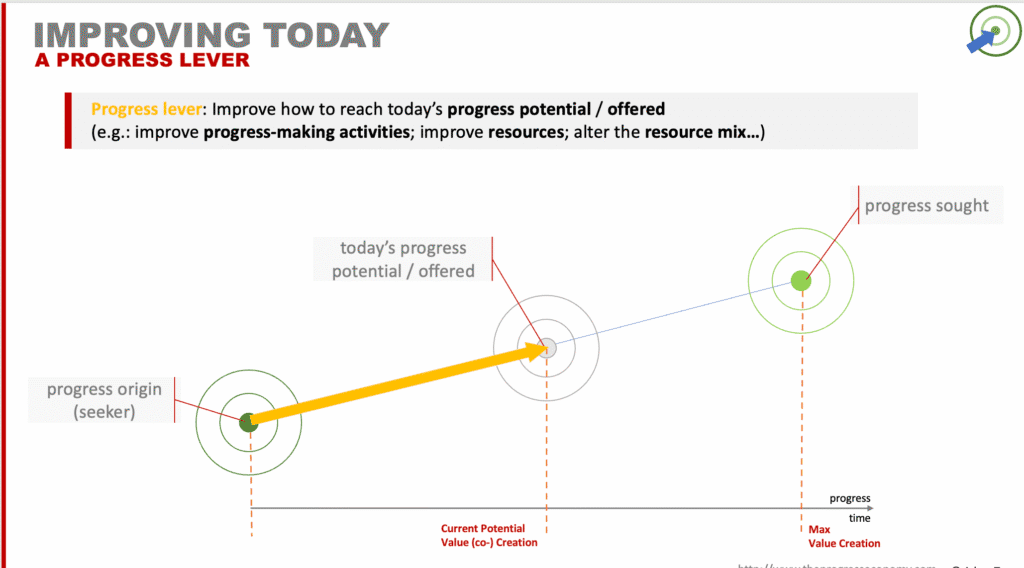
A simple illustration is a chef’s knife. That always needs to be sharp and so requires constant sharpening. If we innovate to improve edge retention, then functional progress sought (cutting food) is unchanged, but we reduces sharpening frequency, removing some friction from the overall cooking process. Technically we have moved closer to progress sought of “getting through a session without needing to sharpen my knife” (which maybe latent progress sought).
Uber is a larger-scale example. They didn’t change the functional progress offered – “get from A to B” – but they dramatically improved how that progress was made. By shifting the resource mix from call-center employees to a mobile app, they made the process faster, more transparent, and more reliable. Features such as real-time vehicle tracking and two-way ratings drove behavioral change on both sides of the platform, leading to better overall experiences.
B2B examples are equally powerful here. Snowflake, for instance, didn’t just store data (a progress offered that is the same as a traditional data warehouse); they simplified setup, scaled infrastructure automatically, and charged on actual usage – making today’s progress dramatically easier and more cost-aligned.
…reducing progress hurdles
Another powerful innovation lever is reducing one or more of the six progress hurdles.
The foundational hurdle is lack of capability – skills, knowledge, physical ability, or natural resources (e.g., power). Propositions exist to address this hurdle. They offer supplementary capabilities carried by resources as well as a set of proposed progress-making activities. There’s often plenty of room to innovate on the resource mix and proposed activities.
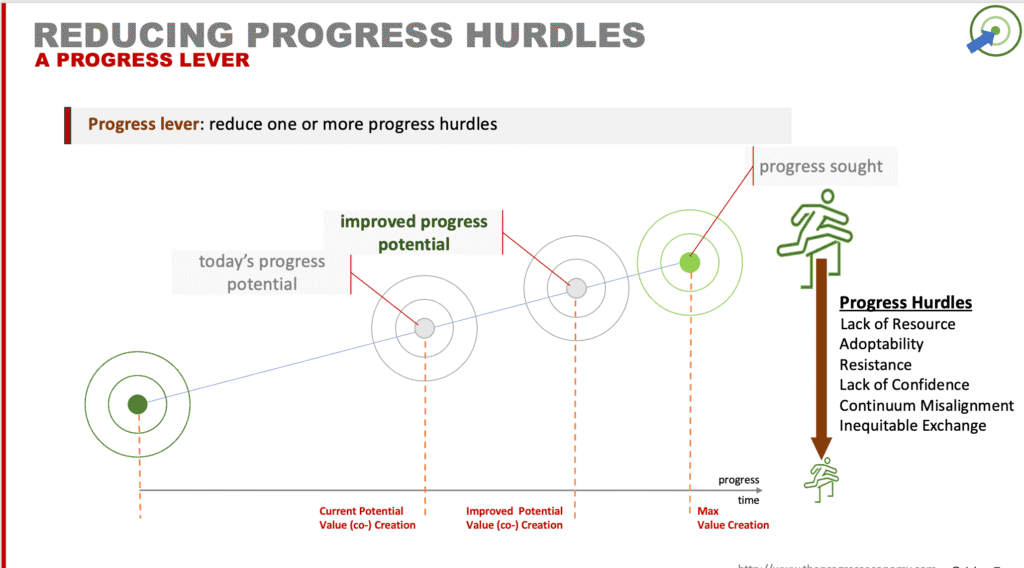
But five additional hurdles also shape whether Seekers engage a proposition:
- Adoptability – Rogers’ classic Diffusion of Innovations
- Resistance – a missing part of Rogers’ framework
- Lack of confidence – does the Seeker trust you and your proposition based on your existing offerings?
- Continuum misalignment – are you offering to relieve/enable as much as Seeker wants?
- Inequitable exchange – is the Seeker comfortable with the level of effort you are expecting from them (most likely indirectly through service credits) in return for you applying your effort?
These hurdles are often interdependent. Reducing lack of capability (ie offering more) may drive up exchange requirements. Moving along the progress continuum to more relieving proposition may lower perceived risk, reducing resistance, and increasing confidence but also increases exchange needs. Whereas moving towards enabling propositions increases adoptability hurdle but may align better with how the Seeker wants to make progress.
…increasing value recognition frequency
The last high-level lever in our innovation definition focuses on helping Seekers recognise value earlier and more often.
Value may be emerging continuously as progress is made, but unless the Seeker recognise that value, it is meaningless to them. Each Seeker has their own threshold for when emerged value feels “real.” Our innovation challenge is to create a cadence of recognition that keeps the Seeker engaged and motivated.
The worst-case scenario is a Seeker who only recognises value upon reaching their progress sought. Until then, they may lose energy, doubt the journey, and abandon the attempt entirely or switch to another proposition.
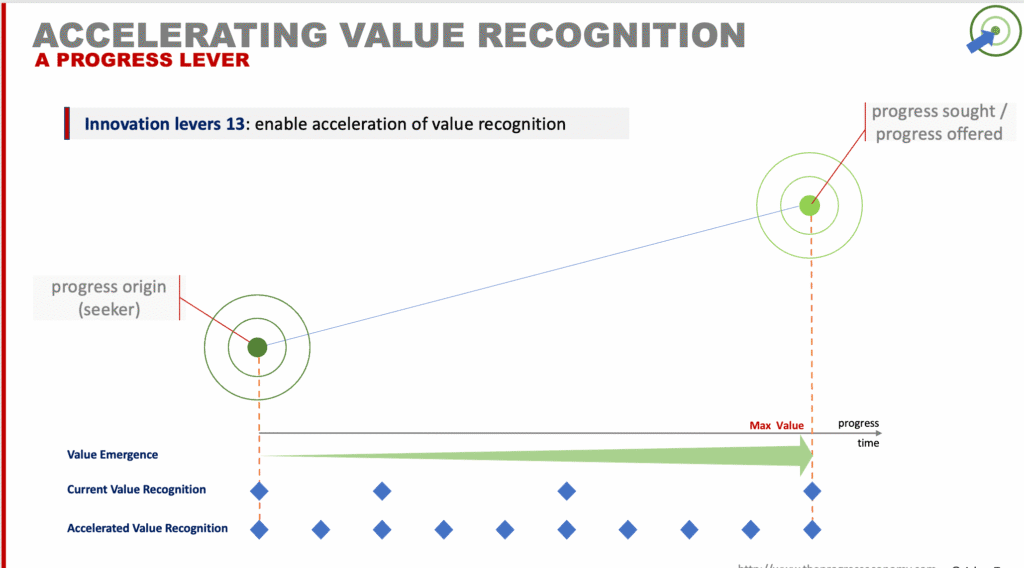
An example would be switching to an Agile approach to making progress. Agile deliberately breaks the journey into increments, with review points after each iteration. This allows Seekers – whether customers, users, or internal stakeholders – to recognise emerged value earlier, experience momentum, and adjust the next steps to compound what is working.
You can see the same principle in how leading SaaS providers design onboarding. Rather than expecting customers to master the entire platform before recognising value, they deliberately create early “aha moments.” For example, project management software firms like Asana or Monday.com ensure new users experience success within minutes — by setting up their first task, inviting a colleague, or automating a simple workflow. Each early win is a recognition of value, anchoring the Seeker’s belief that the platform will continue to support their larger progress sought. This reduces abandonment risk, accelerates adoption, and strengthens long-term engagement.
Industrial equipment manufacturers now embed sensors and digital dashboards to provide real-time feedback on performance improvements or cost savings. Instead of waiting for a quarterly report to see ROI, customers can see reduced downtime or energy usage immediately. In consulting, firms that share quick wins – for instance, highlighting early operational savings in a transformation project – give clients confidence that the larger initiative will deliver. This “early recognition” strengthens trust, reduces project abandonment, and increases appetite for additional collaboration.
….whilst maintaining, or improving, the survivability of the innovator and/or ecosystem
Finally, any innovation must also ensure the continued survivability of the Helper — and, where relevant, the broader ecosystem that supports the progress journey.
Survivability means attracting enough service exchanges, of sufficient size, to cover the effort being invested and to generate the surplus required for growth. In traditional terms, this means generating revenue and profit. In Progress Economy terms, survivability is reframed as ensuring equitable effort and service exchange, mediated by service credits — of which money is only one form.
This reframing is subtle but important. When we think in terms of service exchange rather than simply “value-in-exchange,” new business model innovations become easier to see. Subscription models (shifting from one-off exchanges to recurring flows), subsidised models (freemium or cross-subsidisation), or ecosystem models (where one Helper absorbs costs so others can flourish) emerge naturally from a progress-first perspective. These designs are often invisible if we frame survivability only through transactional cash exchange.
Some interesting innovations happen inside the Helper organisation itself. Here, the Seeker can be reframed as the organisation, with internal departments acting as Helpers. The progress sought might be greater efficiency, resilience, or adaptability. Innovations such as robotic process automation (RPA) in finance departments, Toyota’s production system on the factory floor, or DevOps pipelines in IT all serve to help the organisation make better progress. They may not change the progress offered to external Seekers directly, but they strengthen the organisation’s ability to keep doing so.
At an ecosystem level, survivability must extend beyond the firm. Amazon Web Services, for example, created an infrastructure platform that not only ensured Amazon’s own survivability but also underpinned the growth of thousands of start-ups. Siemens’ MindSphere, its industrial IoT platform, similarly strengthens the ecosystem by enabling partners and customers to co-innovate in ways that benefit all participants.
Operationalising innovation – progress levers
What is exciting about this definition is that it begins to reveal the levers we can use to drive innovation in a more systematic way. You can already spot the high-level ones embedded in the definition itself:
- Improving how today’s progress is made
- Improving beyond today’s progress (in the direction of progress sought)
- Reducing progress hurdles
- Accelerating value recognition
Beneath these sit more operational levers:
- Aligning proposition progress origins with Seekers’
- Updating the proposed-progress making activities
- Moving those progress making activities to be guided/mandated in system flows; or freeing them up
- Sliding along the progress proposition continuum – to where your Seekers are sitting on the continuum in terms of looking to be enabled/relieved
- Improving an aspect of the current progress resource mix
- Reconfiguring the progress resource mix
- more…
And not just that, our view of progress also reveals more of these levers:
- Recognising Seekers’ progress sought and progress origins evolve over time – you need to, as Drucker tells us, !innovate or die”
- Segmenting propositions by progress (sought and/or origin) is more powerful compared to demographic segmentation
- more…
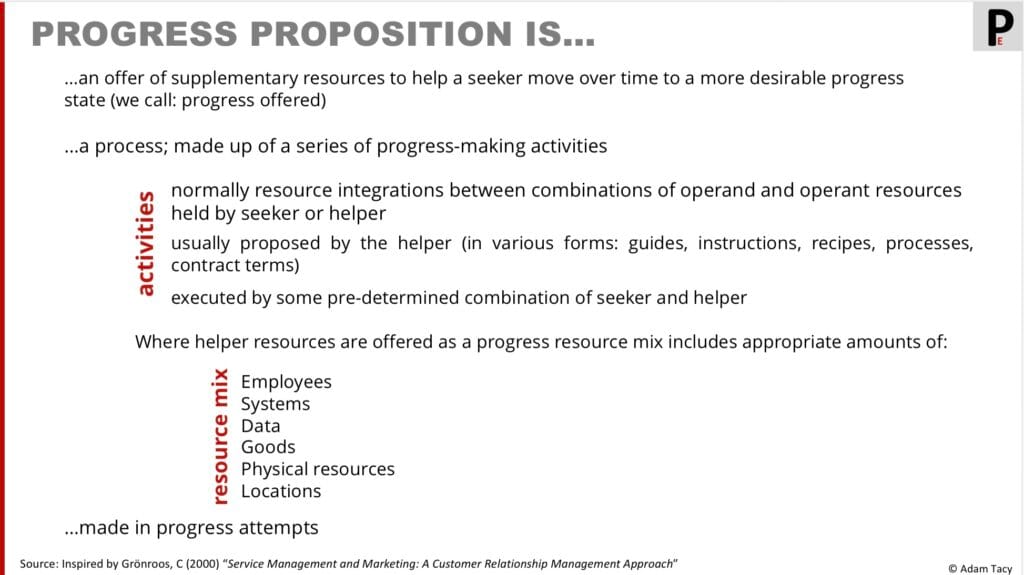
Let’s progress together through discussion…